
Introduction
Dental low – speed external handpieces play a pivotal role in modern dental practices. They are designed to operate at lower rotational speeds compared to their high – speed counterparts, typically ranging from a few hundred to around 40,000 revolutions per minute (RPM). This characteristic makes them ideal for a variety of delicate dental procedures, such as polishing, finishing, and certain types of root canal treatments. Understanding the technical aspects of these handpieces, including their proper use, maintenance, and safety considerations, is essential for dental professionals to ensure optimal patient care and equipment longevity.
Design and Components
Motor and Drive System
The heart of a dental low – speed external handpiece is its motor. These motors are often electric – powered and are designed to provide a stable and adjustable low – speed output. The drive system, which transfers the rotational motion from the motor to the handpiece head, may use a variety of mechanisms. Belt – driven systems are common, where a flexible belt connects the motor pulley to the handpiece pulley. This design allows for smooth power transmission and can help dampen vibrations. Gear – driven systems are also utilized, offering higher torque and more precise speed control in some cases. The choice of drive system depends on the specific application and performance requirements of the handpiece.
Handpiece Head
The handpiece head is where the dental instruments, such as burs or polishing cups, are attached. It is designed to hold these instruments securely during operation. The head may have a quick – change mechanism, allowing dentists to easily swap out different instruments without the need for additional tools. This is crucial for efficiency during procedures. The chuck, which grips the instrument, is engineered to provide a tight and reliable hold to prevent the instrument from slipping during use. Some handpieces also feature an adjustable head angle, enabling dentists to access different areas of the mouth more comfortably and precisely.
Cooling and Lubrication Systems
Although low – speed handpieces generate less heat compared to high – speed ones, they still require cooling mechanisms, especially during extended use. Water – based cooling systems are common, where a fine spray of water is directed onto the working area. This not only cools the handpiece and the dental instrument but also helps flush away debris generated during the procedure. In terms of lubrication, the moving parts of the handpiece, such as the bearings in the head and the components of the drive system, need to be lubricated regularly. Lubrication reduces friction, minimizes wear and tear, and ensures smooth operation. Some handpieces have an integrated lubrication system that can be refilled as needed, while others require manual lubrication at specific intervals.
Operation and Usage
Pre – procedure Setup
Before using a dental low – speed external handpiece, several pre – procedure checks are necessary. First, visually inspect the handpiece for any signs of damage, such as cracks in the housing, loose connections, or worn – out parts. Check the instrument (bur or polishing cup) to ensure it is properly seated in the handpiece head. Next, verify the functionality of the cooling system. Ensure that there is an adequate water supply and that the water spray is directed accurately onto the working area. Adjust the speed setting of the handpiece according to the requirements of the procedure. Most low – speed handpieces have variable speed controls, allowing dentists to select the appropriate RPM for tasks like gentle polishing or more aggressive tooth contouring.
During the Procedure
When using the handpiece on a patient, hold it with a firm but comfortable grip. The handpiece should be held at an appropriate angle to the tooth surface to achieve the desired result. For example, when polishing, the angle should be such that the polishing cup makes full and even contact with the tooth enamel. Apply gentle and consistent pressure. Excessive pressure can cause the handpiece to overheat, damage the dental instrument, or cause discomfort to the patient. Monitor the performance of the handpiece during the procedure. Listen for any unusual noises, which could indicate a problem with the motor, drive system, or bearings. If the handpiece starts to vibrate excessively, stop the procedure and investigate the cause.
Maintenance
Cleaning
After each use, it is essential to clean the dental low – speed external handpiece thoroughly. Remove the used dental instrument and use a soft brush or compressed air to clean any debris, such as tooth fragments, dental materials, or polishing compounds, from the handpiece head and the instrument – holding area. Wipe down the entire handpiece with a clean, damp cloth to remove any surface contaminants. For the cooling system, flush the water lines with clean water to prevent the build – up of mineral deposits or debris that could clog the spray nozzle.
Lubrication
Regular lubrication is crucial for the smooth operation and longevity of the handpiece. Follow the manufacturer’s instructions regarding the type of lubricant to use and the lubrication intervals. Generally, the bearings in the handpiece head and the moving parts of the drive system need to be lubricated. Apply the lubricant to the designated lubrication points, which may include small ports or openings on the handpiece. After lubrication, run the handpiece for a short period to distribute the lubricant evenly.
Calibration and Servicing
Periodically, dental low – speed handpieces should be calibrated to ensure that they are operating at the correct speed. Use a handpiece tachometer to measure the rotational speed and compare it to the manufacturer’s specifications. If there is a deviation, adjust the speed control settings as per the manufacturer’s instructions. Additionally, it is advisable to have the handpiece serviced by a qualified technician at regular intervals. The technician can perform a more in – depth inspection, including checking the integrity of the motor, drive system, and cooling system, and replace any worn – out parts.
Safety Considerations
Infection Control
Dental handpieces are in direct contact with patients’ mouths, making infection control a top priority. After each use, the handpiece should be disinfected following proper protocols. This may involve using a high – level disinfectant or autoclaving, depending on the type of handpiece and the manufacturer’s recommendations. Ensure that all parts of the handpiece, including the head, body, and any detachable components, are thoroughly disinfected to prevent the spread of pathogens between patients.
Electrical Safety
Since most dental low – speed external handpieces are electrically powered, electrical safety is of utmost importance. Check the power cord for any signs of damage, such as fraying or exposed wires, before each use. Use the handpiece only with a properly grounded electrical outlet. In case of any electrical malfunctions, such as the handpiece not turning on or emitting a burning smell, immediately unplug the handpiece and have it inspected by a qualified electrician.
In conclusion, dental low – speed external handpieces are sophisticated tools that require proper understanding, use, and maintenance. By following the guidelines outlined in this article, dental professionals can ensure the safe and effective operation of these handpieces, providing high – quality dental care while maximizing the lifespan of the equipment.
